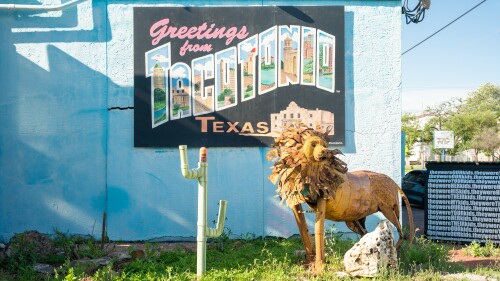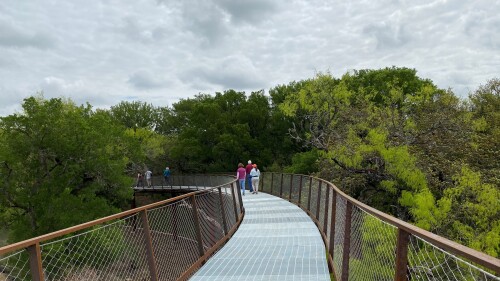The City of San Antonio was founded on 1718, and is the product of three settlements: San Antonio de Valero (church controlled community around the Alamo), San Antonio de Bexar (military garrison on Plaza De Armas) and Villa San Fernando (the civilian town on Main Plaza). Now that 300+ years have passed, the city and its streets are chock-full of vibrant history.
It’s safe to say that over the years, the city has been touched by countless historical figures and happenings — many of which have shaped the names of San Antonio’s buildings, parks, and streets. In this guide, we’re delving into the history of the Alamo City’s streets — specifically how they were named.
Note: We highly recommend “Streets of San Antonio” by Eric C. Mapes if you’re interested in learning more San Antonio street history, we used it extensively in the writing of this piece.
Northwest Side
From Six Flags Fiesta Texas to Friedrich Wilderness Park, this neighborhood is home to some of San Antonio’s popular attractions. On the other hand, it also has its fair share of traffic due to construction on 1604.
De Zavala Road — Named after the generations of the De Zavala family, they have been part of historical events like Mexico’s fight for independence from Spain and Texas’ fight for independence from Mexico.
Evers Road — Claus H. Evers born in 1817 and his wife Johanna K. Brocken Evers born in 1818, both immigrated to Texas on the Gutenberg from Schleswig-Holstein, Germany, in 1855. Their son, Christian Evers, owned as much as 1,300 acres of land in the Leon Valley area.
Fredericksburg Road — John O. Meusebach lead the first 120 settlers to New Braunfels on May 8, 1846 with an 8-men military escort. The naming of Fredericksburg and the subsequent streets are after Prince Frederick of Prussia, a member of the Adelsverein.
Grissom Road — John Grissom and his wife Marie Thompson started multiple businesses in the ranching and dairy industry by selling cattle on credit and renting them with land. John and Marie Grissom donated a right-of-way through their Bexar County ranch creating the name we know today.
Huebner Road — Joseph Huebner came to America in 1853 with his wife Caroline along with their children, Anna and Frank. Huebner was a silversmith, jeweler, and watch repairman with the Bell Brothers Jewelers in downtown. At a point in time, Huebner owned 850 acres in Northwest Bexar County.
Lockehill-Selma — Lockehill was named after the Locke family who settled here in the mid 19th century. The family donated land and operated a school built in 1923 named (get this) Shavano. Whereas Selma remains a mystery. In the 1930’s, the town’s unofficial historian (at the time in his 90’s) doesn’t remember any stories about the name.
Northeast Side
From Converse to Selma and Cibolo, this neighborhood is the quieter part of the city. Far enough to own a plot of land in the Hill Country but close enough to make it out to Amor Eterno on Friday night.
Basse Road — This road pays homage to Edgar A. Basse, Sr., the founder of the Piggly Wiggly supermarket chain.
Cheever Blvd — Named after banking royalty, Elizabeth Daley Cheever — co-founder of Broadway National Bank — and her husband, WWII Army Col. Charles Cheever Sr.
Evans Road — The gold-rushing Texan, Robert Evans, purchased 160 acres of land and was elected Justice of the Peace for Precinct No. 3 in 1872. Evans and his wife Rebecca had nine children. The road honors the family’s name.
Perrin Beitel Road — Taking the name from Joseph and Elizabeth Beitel, this road commemorates the German immigrant family and Joseph’s participation in the Army of the Republic of Texas, according to “Streets of San Antonio” by Eric C. Mapes. He was also elected Bexar County Commissioner for Precinct No. 2 in 1856.
Downtown
The confluence of culture — and the San Antonio River — downtown has everything from romantic getaways to partying until the sun comes up.
Belknap Street — This moniker remebers Augustus Belknap, who implemented the city’s first streetcars which were mule-driven down San Pedro Ave.
Callaghan Road + Avenue — According to Mapes, this winding road downtown is named after the influential Callaghan family. The families shaped the political, social, and economic systems by helping establish fire stations, water systems, and adding road construction. San Antonio has seen three Callaghan mayors: Bryan Callaghan Sr., Bryan Callaghan Jr., and Alfred Callaghan.
Flores Street — One of the oldest streets in San Antonio is named after Nicolas Flores y Valdez, who fought against Native American raids during the Aguayo Expedition in 1817. The goal of the expedition was to open up supply routes. Other sources indicate the road was named Flores Street to the amount of flowers (Flores) that grew along the road.
St. Mary’s Street (and University) — Was named after the brothers of Saint Mary who immigrated to San Antonio in 1851 to start the aptly-named university.
Soledad Street — At one time, this street had only one house on it, so it was named Soledad which is Spanish for lonely.
Travis, Crockett, Bowie, and Bonham streets — These honor the fallen soldiers at the Battle of the Alamo: James Bowie, William B. Travis, David Crockett, and James Bonham.
Inner Westside
You’re not quite in downtown but you’re on its outskirts. Maybe you’ve taken a stroll through Confluence Park or your GPS rerouted you through a neighborhood.
Cupples Road — This road is dubbed after Colonel Cupples, a former agent of Henri Castro.
General McMullen Drive — The street honors a former commander of Kelly Air Force Base.
W. and E. Ashby Place — This street remains a mystery because the Street Renaming Committee in the early 1900’s changed the name to an already existing street to Ashby Place in response to a community petition to honor “General Ashby.” However, this is where the mystery starts. There is no historical record of any general named Ashby in Texas. There was a Civil War brigadier general named Turner Ashby but he was raised, schooled, fought, and died in Virginia during the Civil War. Yet, the street was renamed 50 years after the Civil War.
Far Westside
Braun Road — Named after the son of German immigrants Phillip and Maria Braun, Frederick Braun settled on the Northwest side of the city and helped establish the City of Helotes as well as one of the founding members of the Zion Lutheran Church of Helotes.
Culebra Road — This street intersects other familiar roads like Bandera, Callaghan, Potranco, and Ingram. The winding road is unique as it is not named after a person or family, but instead for it’s length and shape. Simply put: “Culebra” is Spanish for snake.
Galm Road — In 1850 the Galm family had emigrated from Germany to Pennsylvania until moving to Helotes in 1872. Valentine Galm was a successful farmer and held over 150+ acres of land. A generation later, Clarence Galm was heavily involved with the Helotes School Board and in 1987 the Northside Independent School District Board of Trustees dedicated an elementary school to him and his family.















